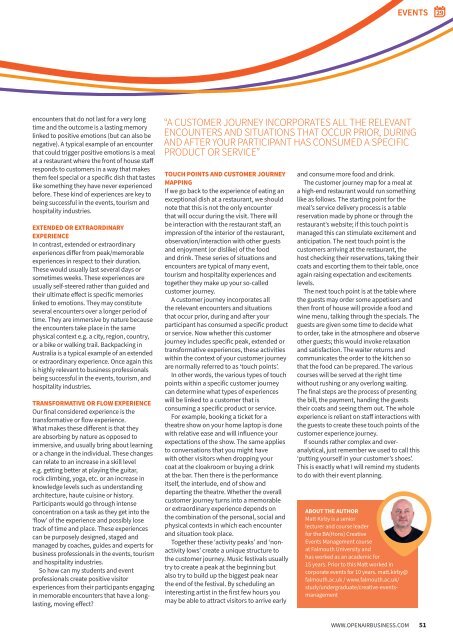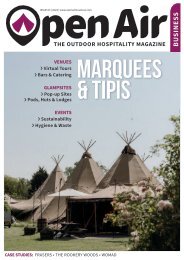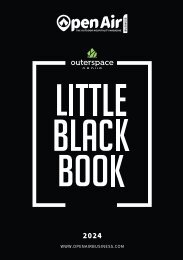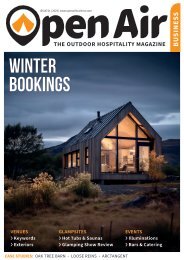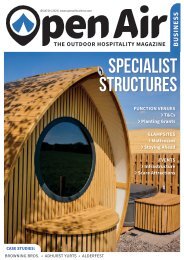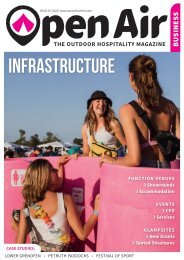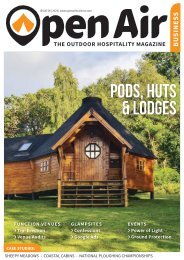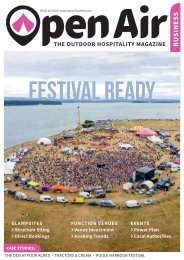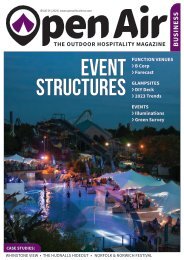Issue 57
The UK's outdoor hospitality business magazine for function venues, glamping, festivals and outdoor events
The UK's outdoor hospitality business magazine for function venues, glamping, festivals and outdoor events
Create successful ePaper yourself
Turn your PDF publications into a flip-book with our unique Google optimized e-Paper software.
EVENTS<br />
encounters that do not last for a very long<br />
time and the outcome is a lasting memory<br />
linked to positive emotions (but can also be<br />
negative). A typical example of an encounter<br />
that could trigger positive emotions is a meal<br />
at a restaurant where the front of house staff<br />
responds to customers in a way that makes<br />
them feel special or a specific dish that tastes<br />
like something they have never experienced<br />
before. These kind of experiences are key to<br />
being successful in the events, tourism and<br />
hospitality industries.<br />
EXTENDED OR EXTRAORDINARY<br />
EXPERIENCE<br />
In contrast, extended or extraordinary<br />
experiences differ from peak/memorable<br />
experiences in respect to their duration.<br />
These would usually last several days or<br />
sometimes weeks. These experiences are<br />
usually self-steered rather than guided and<br />
their ultimate effect is specific memories<br />
linked to emotions. They may constitute<br />
several encounters over a longer period of<br />
time. They are immersive by nature because<br />
the encounters take place in the same<br />
physical context e.g. a city, region, country,<br />
or a bike or walking trail. Backpacking in<br />
Australia is a typical example of an extended<br />
or extraordinary experience. Once again this<br />
is highly relevant to business professionals<br />
being successful in the events, tourism, and<br />
hospitality industries.<br />
TRANSFORMATIVE OR FLOW EXPERIENCE<br />
Our final considered experience is the<br />
transformative or flow experience.<br />
What makes these different is that they<br />
are absorbing by nature as opposed to<br />
immersive, and usually bring about learning<br />
or a change in the individual. These changes<br />
can relate to an increase in a skill level<br />
e.g. getting better at playing the guitar,<br />
rock climbing, yoga, etc. or an increase in<br />
knowledge levels such as understanding<br />
architecture, haute cuisine or history.<br />
Participants would go through intense<br />
concentration on a task as they get into the<br />
‘flow’ of the experience and possibly lose<br />
track of time and place. These experiences<br />
can be purposely designed, staged and<br />
managed by coaches, guides and experts for<br />
business professionals in the events, tourism<br />
and hospitality industries.<br />
So how can my students and event<br />
professionals create positive visitor<br />
experiences from their participants engaging<br />
in memorable encounters that have a longlasting,<br />
moving effect?<br />
“A CUSTOMER JOURNEY INCORPORATES ALL THE RELEVANT<br />
ENCOUNTERS AND SITUATIONS THAT OCCUR PRIOR, DURING<br />
AND AFTER YOUR PARTICIPANT HAS CONSUMED A SPECIFIC<br />
PRODUCT OR SERVICE”<br />
TOUCH POINTS AND CUSTOMER JOURNEY<br />
MAPPING<br />
If we go back to the experience of eating an<br />
exceptional dish at a restaurant, we should<br />
note that this is not the only encounter<br />
that will occur during the visit. There will<br />
be interaction with the restaurant staff, an<br />
impression of the interior of the restaurant,<br />
observation/interaction with other guests<br />
and enjoyment (or dislike) of the food<br />
and drink. These series of situations and<br />
encounters are typical of many event,<br />
tourism and hospitality experiences and<br />
together they make up your so-called<br />
customer journey.<br />
A customer journey incorporates all<br />
the relevant encounters and situations<br />
that occur prior, during and after your<br />
participant has consumed a specific product<br />
or service. Now whether this customer<br />
journey includes specific peak, extended or<br />
transformative experiences, these activities<br />
within the context of your customer journey<br />
are normally referred to as ‘touch points’.<br />
In other words, the various types of touch<br />
points within a specific customer journey<br />
can determine what types of experiences<br />
will be linked to a customer that is<br />
consuming a specific product or service.<br />
For example, booking a ticket for a<br />
theatre show on your home laptop is done<br />
with relative ease and will influence your<br />
expectations of the show. The same applies<br />
to conversations that you might have<br />
with other visitors when dropping your<br />
coat at the cloakroom or buying a drink<br />
at the bar. Then there is the performance<br />
itself, the interlude, end of show and<br />
departing the theatre. Whether the overall<br />
customer journey turns into a memorable<br />
or extraordinary experience depends on<br />
the combination of the personal, social and<br />
physical contexts in which each encounter<br />
and situation took place.<br />
Together these ‘activity peaks’ and ‘nonactivity<br />
lows’ create a unique structure to<br />
the customer journey. Music festivals usually<br />
try to create a peak at the beginning but<br />
also try to build up the biggest peak near<br />
the end of the festival. By scheduling an<br />
interesting artist in the first few hours you<br />
may be able to attract visitors to arrive early<br />
and consume more food and drink.<br />
The customer journey map for a meal at<br />
a high-end restaurant would run something<br />
like as follows. The starting point for the<br />
meal’s service delivery process is a table<br />
reservation made by phone or through the<br />
restaurant’s website; if this touch point is<br />
managed this can stimulate excitement and<br />
anticipation. The next touch point is the<br />
customers arriving at the restaurant, the<br />
host checking their reservations, taking their<br />
coats and escorting them to their table, once<br />
again raising expectation and excitements<br />
levels.<br />
The next touch point is at the table where<br />
the guests may order some appetisers and<br />
then front of house will provide a food and<br />
wine menu, talking through the specials. The<br />
guests are given some time to decide what<br />
to order, take in the atmosphere and observe<br />
other guests; this would invoke relaxation<br />
and satisfaction. The waiter returns and<br />
communicates the order to the kitchen so<br />
that the food can be prepared. The various<br />
courses will be served at the right time<br />
without rushing or any overlong waiting.<br />
The final steps are the process of presenting<br />
the bill, the payment, handing the guests<br />
their coats and seeing them out. The whole<br />
experience is reliant on staff interactions with<br />
the guests to create these touch points of the<br />
customer experience journey.<br />
If sounds rather complex and overanalytical,<br />
just remember we used to call this<br />
‘putting yourself in your customer’s shoes’.<br />
This is exactly what I will remind my students<br />
to do with their event planning.<br />
ABOUT THE AUTHOR<br />
Matt Kirby is a senior<br />
lecturer and course leader<br />
for the BA(Hons) Creative<br />
Events Management course<br />
at Falmouth University and<br />
has worked as an academic for<br />
15 years. Prior to this Matt worked in<br />
corporate events for 10 years. matt.kirby@<br />
falmouth.ac.uk / www.falmouth.ac.uk/<br />
study/undergraduate/creative-eventsmanagement<br />
WWW.OPENAIRBUSINESS.COM 51


